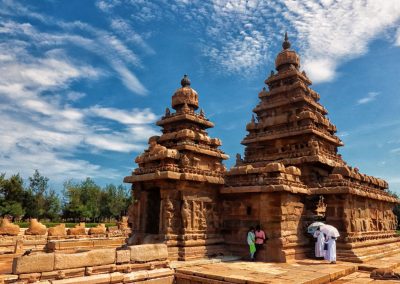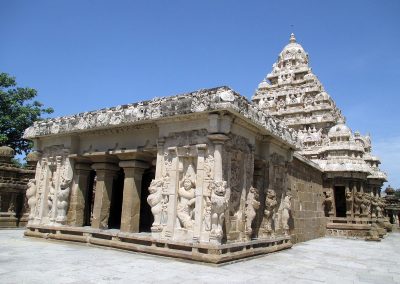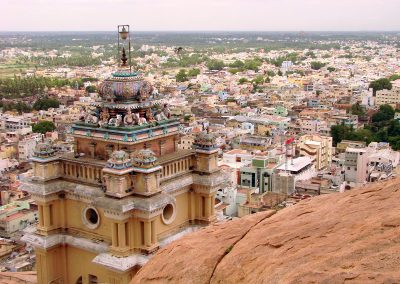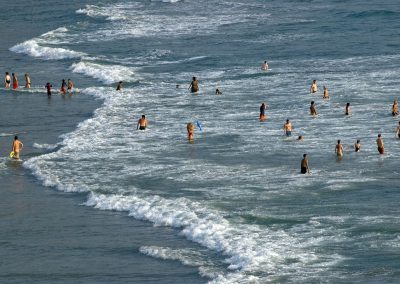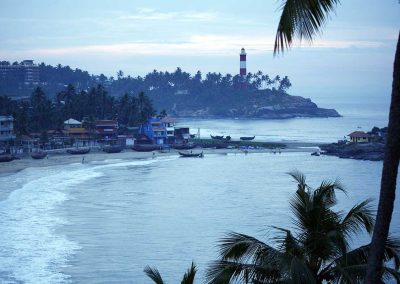Chennai
With its historic landmarks and buildings, long sandy beaches, cultural and art centers and parks, Chennai’s tourism offers many potentially interesting locations to visitors. A notable tourist attraction in Chennai is actually in the neighbouring town of Mahabalipuram, with its ancient temples and rock carvings of the 7th century Pallava kingdom is an UNESCO World Heritage site
Kanchipuram
Kanchipuram also known as Conjeevaram, is a city in the Indian state of Tamil Nadu in the Tondaimandalam region, 72 km (45 mi) from Chennai – the capital of Tamil Nadu. Known as the City of Thousand Temples, Kanchipuram is known for its temple architectures, 1000-pillared halls, huge temple towers and silk sarees. Kanchipuram serves as one of the most important tourist destinations in India. Kanchipuram has become a centre of attraction to the foreign tourists as well.
Kanchipuram is a Tamil word formed by combining two words “Kanchi” and “-puram” meaning “Brahma” and “residential place” respectively and located on the banks of the Vegavathy and Palar river. Kanchipuram has been ruled by the Pallavas, the Medieval Cholas, the Later Cholas, the Later Pandyas, the Vijayanagara Empire, the Carnatic kingdom, and the British, who called the city “Conjeeveram”. The city’s historical monuments include the Kailasanathar Temple and the Vaikunta Perumal Temple. Historically, Kanchipuram was a centre of education and was known as the ghatikasthanam, or “place of learning”. The city was also a religious centre of advanced education for Jainism and Buddhism between the 1st and 5th centuries.
Mamallapuram
Mamallapuram, also known as Mahabalipuram, is a town in Chengalpattu district in the southeastern Indian state of Tamil Nadu, best known for the UNESCO World Heritage Site of 7th- and 8th-century Hindu Group of Monuments at Mahabalipuram. It is one of the famous tourist sites in India. The ancient name of the place is Thirukadalmallai.
Mamallapuram was one of two major port cities in the Pallava kingdom. The town was named after Pallava king Narasimhavarman I, who was also known as Mamalla. Along with economic prosperity, it became the site of a group of royal monuments, many carved out of the living rock. These are dated to the 7th and 8th centuries: rathas (temples in the form of chariots), mandapas (cave sanctuaries), the giant open-air rock relief the Descent of the Ganges, and the Shore Temple dedicated to Shiva. The contemporary town plan was established by the British Raj in 1827.
Pondicherry
Pondicherry is a tourist destination. The city has many colonial buildings, churches, temples and statues which, combined with the town planning and French style avenues in the old part of town, still preserve much of the colonial ambiance.
While the sea is a draw for tourists, Pondicherry no longer has the sandy beaches that once graced its coastline. The breakwater to the harbour and other hard structures constructed on the shore caused extreme coastal erosion and the sand from Pondicherry’s Promenade Beach was permitted to disappear entirely. As a result of the city’s seawall and groyne construction, the beaches further up the coast to the north have also been lost. An enormous deposition of sand has accrued to the south of the harbour breakwater, but this is not a commodious beach and is not easily accessible from the city.
Tiruchirappalli
Tiruchirappalli’s recorded history begins in the 3rd century BC, when it was under the rule of the Cholas. The city has also been ruled by the Pallavas, Pandyas, Vijayanagar Empire, Nayak Dynasty, the Carnatic state and the British. The most prominent historical monuments in Tiruchirappalli include the Rockfort at Teppakulam, the Ranganathaswamy temple at Srirangam dedicated to the reclining form of Hindu God Vishnu, and is also the largest functioning temple in the world, and the Jambukeswarar temple at Thiruvanaikaval, which is also the largest temple for the Hindu God Shiva in the world. The archaeologically important town of Uraiyur, capital of the Early Cholas, is now a neighbourhood in Tiruchirappalli. The city played a critical role in the Carnatic Wars (1746–1763) between the British and the French East India companies.
Madurai
Madurai is closely associated with the Tamil language. The third Tamil Sangam, a major congregation of Tamil scholars said to have been held in the city. The recorded history of the city goes back to the 3rd century BCE, being mentioned by Megasthenes, the Greek ambassador to the Maurya empire, and Kautilya, a minister of the Mauryan emperor Chandragupta Maurya. Signs of human settlements and Roman trade links dating back to 300 BCE are evident from excavations by Archeological Survey of India in Manalur. The city is believed to be of significant antiquity and has been ruled, at different times, by the Pandyas, Cholas, Madurai Sultanate, Vijayanagar Empire, Madurai Nayaks, Carnatic kingdom, and the British East India Company British Raj.
The city has a number of historical monuments, with the Meenakshi Temple and the Thirumalai Nayak Palace being the most prominent. Madurai is an important industrial and educational hub in South Tamil Nadu. The city is home to various automobile, rubber, chemical and granite manufacturing industries.
Kanyakumari
A popular tourist destination in India which is famous for its unique sunrise and sunset point , the 41-metre (133 ft) Thiruvalluvar Statue and Vivekananda Rock Memorial off the coast, and as a pilgrimage centre. Lying at the tip of peninsular India, Kanyakumari is bordered on the west, south and east by the Laccadive Sea. It has a coastal line of 71.5 kilometres (44.4 mi) stretched on the three sides.
Kovalam
The leisure options at this beach are plenty and diverse. Sunbathing, swimming, herbal body toning massages, special cultural programmes and catamaran cruising are some of them. The tropical sun acts so fast that one can see the faint blush of coppery tan on the skin in a matter of minutes. Life on the beach begins late in the day and carries on well into the night. The beach complex includes a string of budget cottages, Ayurvedic health resorts, convention facilities, shopping zones, swimming pools, Yoga and Ayurvedic massage centres.
Accommodation facilities for tourists at Kovalam range from five star hotels to budget hotels and the choice of food available at restaurants and cafeterias range from Continental varieties to South Indian delicacies.
Thiruvananthapuram, the capital city of Kerala, is just 16 km away from Kovalam and getting there is no hassle. But if you are on holiday it is better to stay in Kovalam and visit the city. The city of Thiruvananthapuram has many interesting places to see like the Napier Museum, the Sri Chitra Art Gallery and the Padmanabhaswamy Temple. The SMSM Institute, a State owned handicrafts emporium, is the ideal place to pick up ethnic curios and other articles.
Thiruvananthapuram
Varkala
The Papanasam Beach (also called as Varkala Beach), which is ten kilometers away from Varkala, is renowned for a natural spring. Which is considered to have medicinal and curative properties. A dip in the holy waters at this beach is believed to purge the body of impurities and the soul of all sins; hence the name ‘Papanasam Beach’.
A two thousand-year-old shrine the Janardhanaswamy Temple stands on the cliffs overlooking the beach, a short distance away. The Sivagiri Mutt, founded by the great religious reformer and philosopher Sree Narayana Guru (1856 – 1928) is also close by. The Samadhi (the final resting place) of the Guru here attracts thousands of devotees every year during the Sivagiri Pilgrimage days – 30th December to 1st January. Sree Narayana Guru propagated the ideology: “one caste, one religion and one God”, in a society torn by the taboos of caste system.
Varkala offers excellent accommodation facilities for tourists and is fast becoming a popular health resort with many Ayurvedic massage centres.
Alappuzha
Affectionately nicknamed the ‘Venice of the East’ by travellers from across the world, Alappuzha is a district of immense natural beauty. Embraced by the Arabian Sea in the west and a network of lakes, lagoons and freshwater rivers criss-crossing it, this backwater country is home toa vibrant animal and avian life. By virtue of its proximity to the sea, the town has always carved out an exclusive place for itself in the maritime history of Kerala.
Renowned for its boat races, beaches, marine products and coir industry, the singularity of this land is the region called Kuttanad. A land of lush paddy fields referred to as the ‘Rice Bowl of Kerala’, it is one of the few places in the world where farming is done below sea level. This once prosperous trading and fishing centre is nowadays a world renowned backwater tourist destination.
Thekkady
Kochi
Kochi formerly known as Cochin, is a city in the Indian state of Kerala. It is the most popular tourist destination for both domestic and international visitors to Kerala and is among the most visited tourist destinations in India. MICE tourism, LuLu Mall, the Wonderla water theme park, and the metro nature of Kochi city were the main aspects for attracting more domestic tourists.
Popularly known as the Queen of Arabian Sea, the city also flaunts one of the finest natural harbors of the world and was the centre of the world spice trade for many centuries. Old Kochi (presently called West Kochi), loosely refers to a group of islands which comprise Willingdon Island, Fort Kochi, Mattancherry etc. The city derives its name from the Malayalam word Kochazhi meaning small lagoon.



